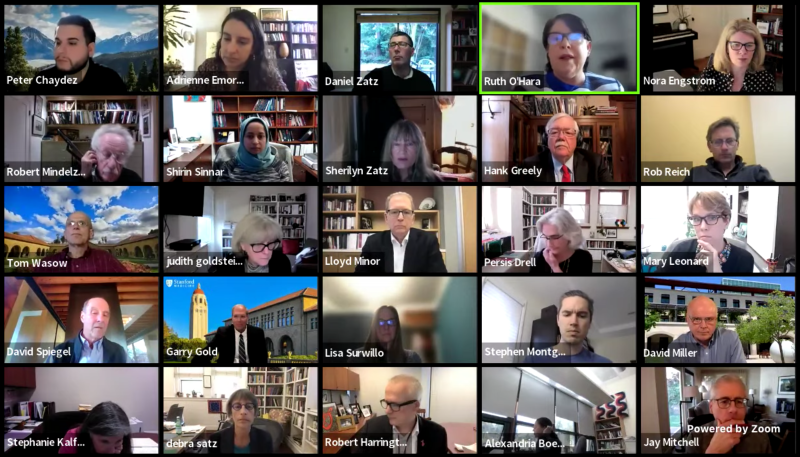The Stanford School of Medicine plans to expand clinical research and healthcare access for historically marginalized and underserved populations, said faculty leaders during Thursday’s Faculty Senate meeting.
While racial minorities represent 40% of the world’s population, 75% of participants in FDA approved clinical trials identified as white in 2020, according to Dean of the School of Medicine Lloyd Minor. To address this discrepancy, Minor said that Stanford Medicine aims to increase patient access to clinical trials such that Stanford can serve a more diverse set of communities.
“Clinical trial expansion is the best opportunity for patients to receive state of the art care,” Minor said.
The recent addition of two new hospital facilities in Palo Alto — Stanford Health Care Hospital in 2019 and Lucile Packard Children’s Hospital in 2018 — has allowed for around 30% growth in the number of both in-patient beds and emergency department bays, according to Minor. Beyond just serving Stanford and Palo Alto residents, the medical school’s growth strategy aims to encompass additional care for the greater Bay Area community. Currently, Stanford Medicine has 82 outpatient locations through Stanford Health Care and 65 outpatient locations through Stanford Children’s Health, Minor added.
The outpatient centers off the peninsula provide greater access to healthcare for communities in cities such as Oakland and San Jose — many of which are underserved, Minor said. He added that clinics like the South Bay Cancer Center and East Bay Oncology, both staffed by Stanford faculty, expand the network of clinical trials for rare diseases and cancer to a more demographically diverse population.
This Bay-Area-wide system of care makes Stanford’s high-quality medical attention and innovative research more accessible, according to Minor, thus creating greater equity in access to clinical trials in patients’ home communities and decreasing the need to commute to on-campus facilities. Chair of the Department of Medicine Bob Harrington echoed the value of increased accessibility.
“The ability to reach our patients where they truly live … makes it easier for our patients to see us and for them to potentially participate in research,” Harrington said. “These ambulatory sites are a critical part of our future.”
Stanford’s Health Equity Committee, which aims to identify ways to better serve a diverse set of patients, is implementing a new health equity initiative entitled Racial Equity to Advance a Community of Health (REACH), according to Minor. With a recent $25 million gift, Stanford will fund over 700 students from historically underserved communities to pursue projects in the area of health equity over the next five years, Minor said.
President and CEO of Stanford Children’s Health Paul King said that initiatives such as the Teen Van Program, which provides essential care and support to youth in underserved communities and high schools, also work to bridge the gap in healthcare disparities.
For Minor, the initiatives are the beginning of a larger mission.
“This is just the start to the type of impact we want to have,” Minor said. “Disparities of health and healthcare that have always existed in our society have become clearly evident during COVID-19 … we should have an impact in this important area.”
Within the medical school, Minor said that 22.4% of the student body identifies as an underrepresented minority — a percentage that Minor expects to rise even further because all financial aid has become need-based and full grants are supported without medical school loans.
During COVID-19 updates portion of the meeting, Minor said that over one million PCR tests were provided through Stanford Health Care.
Alongside testing milestones, Stanford Medicine saw the growing importance of telehealth as a way to reach a greater number of patients from a wide variety of backgrounds. Stanford telehealth services soared from 2% of out-patient visits to nearly 70% during the pandemic, according to President and CEO of Stanford Health Care David Entwistle.
Virtual services, alongside the aforementioned off-site outpatient clinics, are examples of ways Stanford Medicine is spreading its resources, according to King.
“There are many things we can do that can be done safely and at very high quality in ambulatory settings, and even through the use of telehealth,” King said.
In light of the recent death of Katie Meyer, as well as graduate students Jacob Meisel, Rose Wong and Dylan Simmons within the last year, Senators took time during the meeting to address the need for community support.
“We are focusing on supporting the community during difficult times in the tragedy of Katie Meyer’s death,” said Stanford President Marc Tessier-Lavigne.
“We’re doing everything we can, but it is something that requires everybody’s help,” added professor of radiology Garry Gold. “If anyone hears of a student who is talking in a way that makes them think they might be at risk, the best thing to do is seek help immediately.”
A previous version of this article incorrectly stated that Stanford Medicine was seeking to add 82 outpatient locations through Stanford Health Care and 65 outpatient locations through Stanford Children’s Health. These numbers are actually the current amount of outpatient locations. The Daily regrets this error.
